Importance of Therapeutic Relationship in Discharge Planning in Mental Healthcare Setting
VerifiedAdded on 2023/01/24
|11
|3391
|1
AI Summary
This case study highlights the importance of the therapeutic relationship in discharge planning in a mental healthcare setting and provides strategies to facilitate learning needs and an appropriate discharge plan.
Contribute Materials
Your contribution can guide someone’s learning journey. Share your
documents today.

STUDENT NAME STUDENT ID 1 | P a g e
Contents
INTRODUCTION...........................................................................................................................................2
NURSE PATIENT THERAPEUTIC RELATIONSHIP............................................................................................2
STRATEGIES.................................................................................................................................................3
STRATEGIES TO ADDRESS THE ISSUES.........................................................................................................6
Contents
INTRODUCTION...........................................................................................................................................2
NURSE PATIENT THERAPEUTIC RELATIONSHIP............................................................................................2
STRATEGIES.................................................................................................................................................3
STRATEGIES TO ADDRESS THE ISSUES.........................................................................................................6
Secure Best Marks with AI Grader
Need help grading? Try our AI Grader for instant feedback on your assignments.

STUDENT NAME STUDENT ID 2 | P a g e
INTRODUCTION
Intraprofessional communication and coordination dictates success in healthcare discipline. The
concept’s relevance further increases, in context of healthcare professional experience and care
setting for example mental health setting (Herm, 2015, p 3). Mental health nursing is quite a
complex process that requires in-depth knowledge and skills to achieve the best possible
healthcare outcome. The patient within the mental health setting are highly vulnerable and
requires adequate care. The importance of therapeutic relationship in the mental healthcare
setting has been extensively studied with evidenced advantages of continuity of care until the
transition to the community, reduced re-admission, tackling personal and emotional elements of
care, facilitation of community services and increased access to services (Tyler, Wright, &
Warning, 2019, p 883). The integration of nurse professionals and their practice towards a
therapeutic relationship building helps in addressing behavioural change interventions
(McAlister et al., 2019, p 106).
In this case study, Victoria is a registered nurse who is involved in providing care to Mrs. Mary
Brown, who is suffering from acute depression. The scope of this case study will highlight the
importance of the therapeutic relationship in discharge planning in a mental healthcare setting.
The essay will also highlight the strategies Victoria can implement to facilitate Mrs. Brown's
learning needs to facilitate an appropriate discharge plan
NURSE PATIENT THERAPEUTIC RELATIONSHIP
Nurse patient therapeutic relationship allows both the persons to develop self-care goals, and
independence. Trust and open communication are the mainstay of therapeutic relationship.
Discharge process is an art and the way it has to be conducted implies expertise of healthcare
professional facilitating discharge care and education. Research demonstrates, the nurse-patient
relationship is based on patient centered communication to identify the needs. There are four
aspects of the communicative behaviour that can help Victoria in establishing a therapeutic
INTRODUCTION
Intraprofessional communication and coordination dictates success in healthcare discipline. The
concept’s relevance further increases, in context of healthcare professional experience and care
setting for example mental health setting (Herm, 2015, p 3). Mental health nursing is quite a
complex process that requires in-depth knowledge and skills to achieve the best possible
healthcare outcome. The patient within the mental health setting are highly vulnerable and
requires adequate care. The importance of therapeutic relationship in the mental healthcare
setting has been extensively studied with evidenced advantages of continuity of care until the
transition to the community, reduced re-admission, tackling personal and emotional elements of
care, facilitation of community services and increased access to services (Tyler, Wright, &
Warning, 2019, p 883). The integration of nurse professionals and their practice towards a
therapeutic relationship building helps in addressing behavioural change interventions
(McAlister et al., 2019, p 106).
In this case study, Victoria is a registered nurse who is involved in providing care to Mrs. Mary
Brown, who is suffering from acute depression. The scope of this case study will highlight the
importance of the therapeutic relationship in discharge planning in a mental healthcare setting.
The essay will also highlight the strategies Victoria can implement to facilitate Mrs. Brown's
learning needs to facilitate an appropriate discharge plan
NURSE PATIENT THERAPEUTIC RELATIONSHIP
Nurse patient therapeutic relationship allows both the persons to develop self-care goals, and
independence. Trust and open communication are the mainstay of therapeutic relationship.
Discharge process is an art and the way it has to be conducted implies expertise of healthcare
professional facilitating discharge care and education. Research demonstrates, the nurse-patient
relationship is based on patient centered communication to identify the needs. There are four
aspects of the communicative behaviour that can help Victoria in establishing a therapeutic
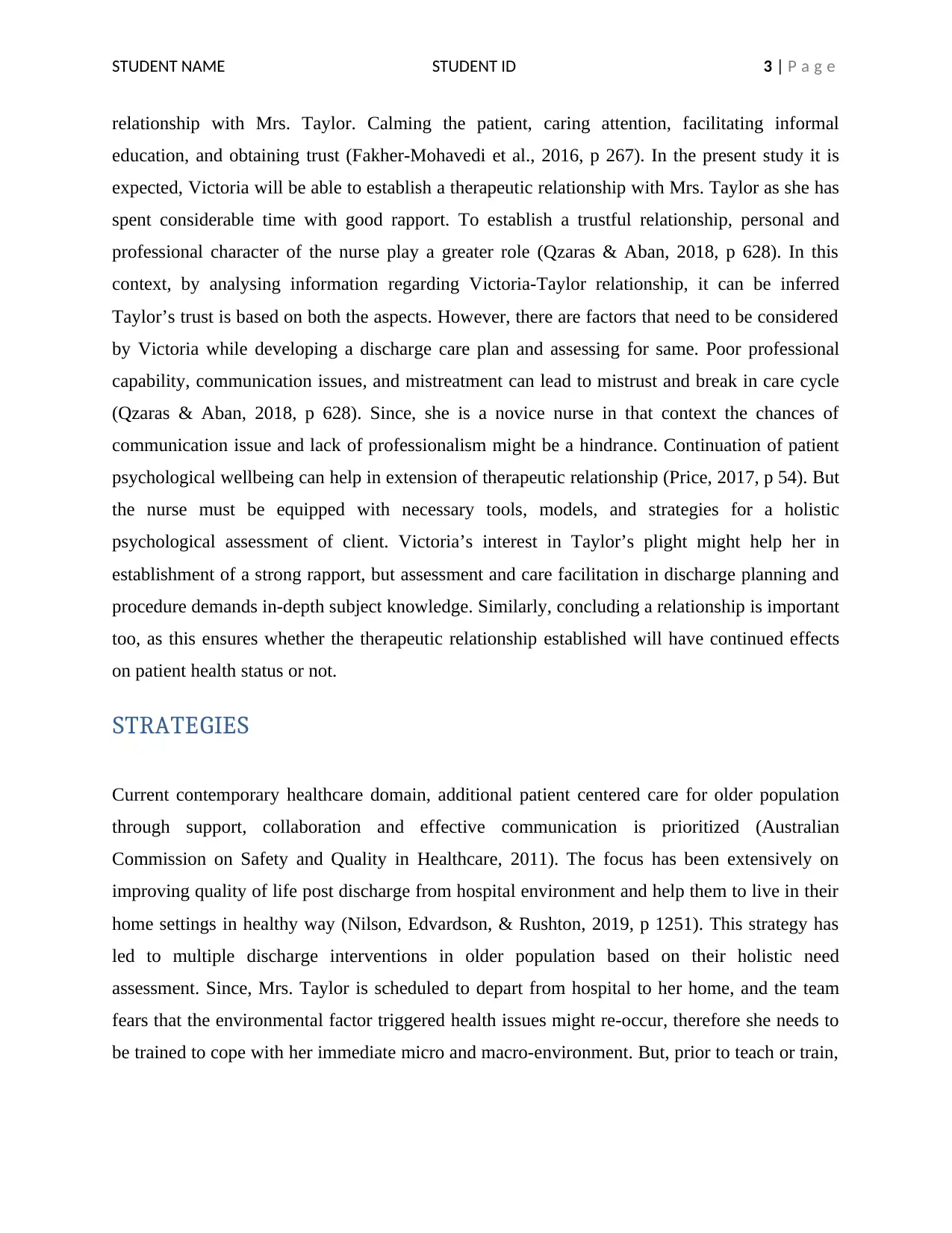
STUDENT NAME STUDENT ID 3 | P a g e
relationship with Mrs. Taylor. Calming the patient, caring attention, facilitating informal
education, and obtaining trust (Fakher-Mohavedi et al., 2016, p 267). In the present study it is
expected, Victoria will be able to establish a therapeutic relationship with Mrs. Taylor as she has
spent considerable time with good rapport. To establish a trustful relationship, personal and
professional character of the nurse play a greater role (Qzaras & Aban, 2018, p 628). In this
context, by analysing information regarding Victoria-Taylor relationship, it can be inferred
Taylor’s trust is based on both the aspects. However, there are factors that need to be considered
by Victoria while developing a discharge care plan and assessing for same. Poor professional
capability, communication issues, and mistreatment can lead to mistrust and break in care cycle
(Qzaras & Aban, 2018, p 628). Since, she is a novice nurse in that context the chances of
communication issue and lack of professionalism might be a hindrance. Continuation of patient
psychological wellbeing can help in extension of therapeutic relationship (Price, 2017, p 54). But
the nurse must be equipped with necessary tools, models, and strategies for a holistic
psychological assessment of client. Victoria’s interest in Taylor’s plight might help her in
establishment of a strong rapport, but assessment and care facilitation in discharge planning and
procedure demands in-depth subject knowledge. Similarly, concluding a relationship is important
too, as this ensures whether the therapeutic relationship established will have continued effects
on patient health status or not.
STRATEGIES
Current contemporary healthcare domain, additional patient centered care for older population
through support, collaboration and effective communication is prioritized (Australian
Commission on Safety and Quality in Healthcare, 2011). The focus has been extensively on
improving quality of life post discharge from hospital environment and help them to live in their
home settings in healthy way (Nilson, Edvardson, & Rushton, 2019, p 1251). This strategy has
led to multiple discharge interventions in older population based on their holistic need
assessment. Since, Mrs. Taylor is scheduled to depart from hospital to her home, and the team
fears that the environmental factor triggered health issues might re-occur, therefore she needs to
be trained to cope with her immediate micro and macro-environment. But, prior to teach or train,
relationship with Mrs. Taylor. Calming the patient, caring attention, facilitating informal
education, and obtaining trust (Fakher-Mohavedi et al., 2016, p 267). In the present study it is
expected, Victoria will be able to establish a therapeutic relationship with Mrs. Taylor as she has
spent considerable time with good rapport. To establish a trustful relationship, personal and
professional character of the nurse play a greater role (Qzaras & Aban, 2018, p 628). In this
context, by analysing information regarding Victoria-Taylor relationship, it can be inferred
Taylor’s trust is based on both the aspects. However, there are factors that need to be considered
by Victoria while developing a discharge care plan and assessing for same. Poor professional
capability, communication issues, and mistreatment can lead to mistrust and break in care cycle
(Qzaras & Aban, 2018, p 628). Since, she is a novice nurse in that context the chances of
communication issue and lack of professionalism might be a hindrance. Continuation of patient
psychological wellbeing can help in extension of therapeutic relationship (Price, 2017, p 54). But
the nurse must be equipped with necessary tools, models, and strategies for a holistic
psychological assessment of client. Victoria’s interest in Taylor’s plight might help her in
establishment of a strong rapport, but assessment and care facilitation in discharge planning and
procedure demands in-depth subject knowledge. Similarly, concluding a relationship is important
too, as this ensures whether the therapeutic relationship established will have continued effects
on patient health status or not.
STRATEGIES
Current contemporary healthcare domain, additional patient centered care for older population
through support, collaboration and effective communication is prioritized (Australian
Commission on Safety and Quality in Healthcare, 2011). The focus has been extensively on
improving quality of life post discharge from hospital environment and help them to live in their
home settings in healthy way (Nilson, Edvardson, & Rushton, 2019, p 1251). This strategy has
led to multiple discharge interventions in older population based on their holistic need
assessment. Since, Mrs. Taylor is scheduled to depart from hospital to her home, and the team
fears that the environmental factor triggered health issues might re-occur, therefore she needs to
be trained to cope with her immediate micro and macro-environment. But, prior to teach or train,
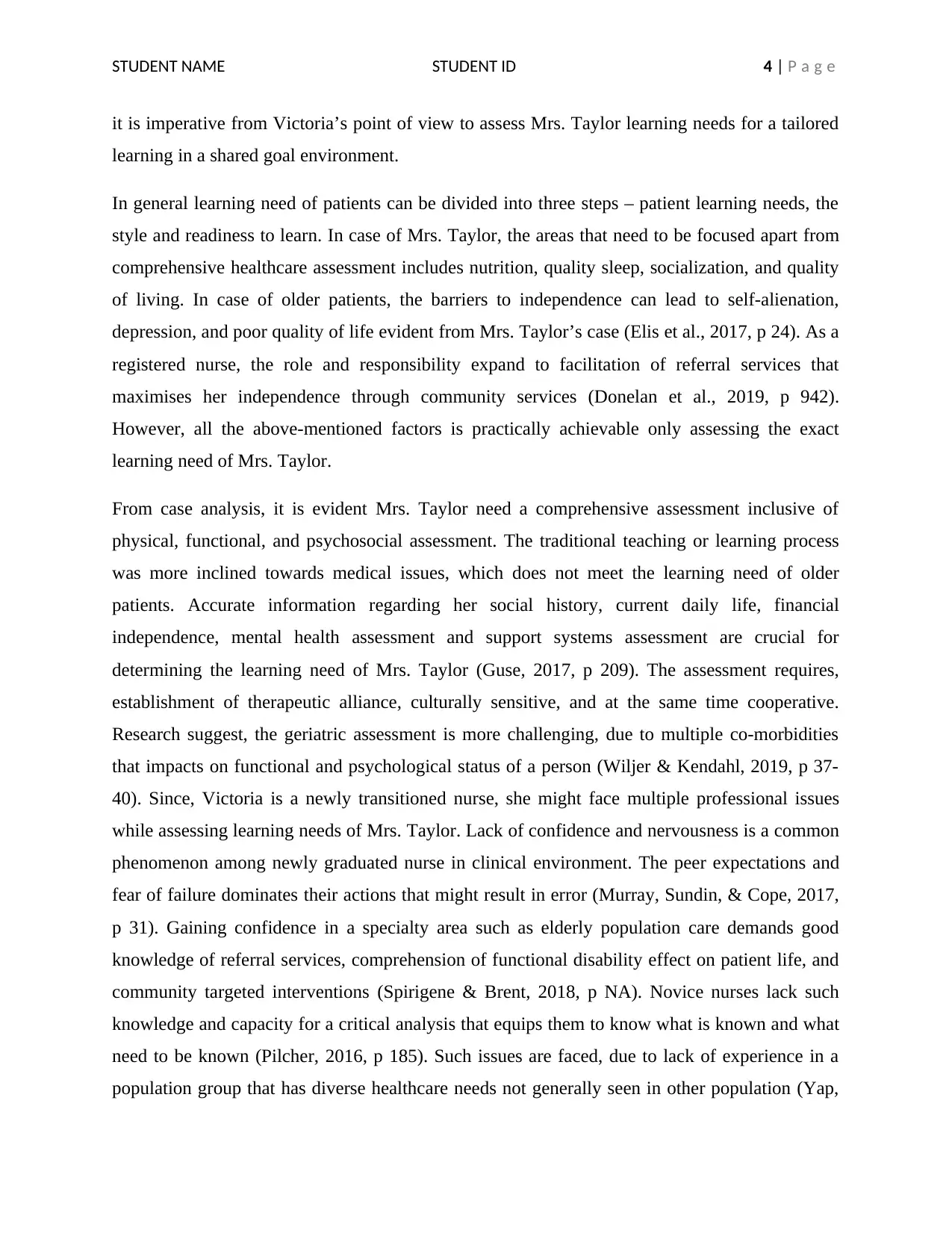
STUDENT NAME STUDENT ID 4 | P a g e
it is imperative from Victoria’s point of view to assess Mrs. Taylor learning needs for a tailored
learning in a shared goal environment.
In general learning need of patients can be divided into three steps – patient learning needs, the
style and readiness to learn. In case of Mrs. Taylor, the areas that need to be focused apart from
comprehensive healthcare assessment includes nutrition, quality sleep, socialization, and quality
of living. In case of older patients, the barriers to independence can lead to self-alienation,
depression, and poor quality of life evident from Mrs. Taylor’s case (Elis et al., 2017, p 24). As a
registered nurse, the role and responsibility expand to facilitation of referral services that
maximises her independence through community services (Donelan et al., 2019, p 942).
However, all the above-mentioned factors is practically achievable only assessing the exact
learning need of Mrs. Taylor.
From case analysis, it is evident Mrs. Taylor need a comprehensive assessment inclusive of
physical, functional, and psychosocial assessment. The traditional teaching or learning process
was more inclined towards medical issues, which does not meet the learning need of older
patients. Accurate information regarding her social history, current daily life, financial
independence, mental health assessment and support systems assessment are crucial for
determining the learning need of Mrs. Taylor (Guse, 2017, p 209). The assessment requires,
establishment of therapeutic alliance, culturally sensitive, and at the same time cooperative.
Research suggest, the geriatric assessment is more challenging, due to multiple co-morbidities
that impacts on functional and psychological status of a person (Wiljer & Kendahl, 2019, p 37-
40). Since, Victoria is a newly transitioned nurse, she might face multiple professional issues
while assessing learning needs of Mrs. Taylor. Lack of confidence and nervousness is a common
phenomenon among newly graduated nurse in clinical environment. The peer expectations and
fear of failure dominates their actions that might result in error (Murray, Sundin, & Cope, 2017,
p 31). Gaining confidence in a specialty area such as elderly population care demands good
knowledge of referral services, comprehension of functional disability effect on patient life, and
community targeted interventions (Spirigene & Brent, 2018, p NA). Novice nurses lack such
knowledge and capacity for a critical analysis that equips them to know what is known and what
need to be known (Pilcher, 2016, p 185). Such issues are faced, due to lack of experience in a
population group that has diverse healthcare needs not generally seen in other population (Yap,
it is imperative from Victoria’s point of view to assess Mrs. Taylor learning needs for a tailored
learning in a shared goal environment.
In general learning need of patients can be divided into three steps – patient learning needs, the
style and readiness to learn. In case of Mrs. Taylor, the areas that need to be focused apart from
comprehensive healthcare assessment includes nutrition, quality sleep, socialization, and quality
of living. In case of older patients, the barriers to independence can lead to self-alienation,
depression, and poor quality of life evident from Mrs. Taylor’s case (Elis et al., 2017, p 24). As a
registered nurse, the role and responsibility expand to facilitation of referral services that
maximises her independence through community services (Donelan et al., 2019, p 942).
However, all the above-mentioned factors is practically achievable only assessing the exact
learning need of Mrs. Taylor.
From case analysis, it is evident Mrs. Taylor need a comprehensive assessment inclusive of
physical, functional, and psychosocial assessment. The traditional teaching or learning process
was more inclined towards medical issues, which does not meet the learning need of older
patients. Accurate information regarding her social history, current daily life, financial
independence, mental health assessment and support systems assessment are crucial for
determining the learning need of Mrs. Taylor (Guse, 2017, p 209). The assessment requires,
establishment of therapeutic alliance, culturally sensitive, and at the same time cooperative.
Research suggest, the geriatric assessment is more challenging, due to multiple co-morbidities
that impacts on functional and psychological status of a person (Wiljer & Kendahl, 2019, p 37-
40). Since, Victoria is a newly transitioned nurse, she might face multiple professional issues
while assessing learning needs of Mrs. Taylor. Lack of confidence and nervousness is a common
phenomenon among newly graduated nurse in clinical environment. The peer expectations and
fear of failure dominates their actions that might result in error (Murray, Sundin, & Cope, 2017,
p 31). Gaining confidence in a specialty area such as elderly population care demands good
knowledge of referral services, comprehension of functional disability effect on patient life, and
community targeted interventions (Spirigene & Brent, 2018, p NA). Novice nurses lack such
knowledge and capacity for a critical analysis that equips them to know what is known and what
need to be known (Pilcher, 2016, p 185). Such issues are faced, due to lack of experience in a
population group that has diverse healthcare needs not generally seen in other population (Yap,
Secure Best Marks with AI Grader
Need help grading? Try our AI Grader for instant feedback on your assignments.
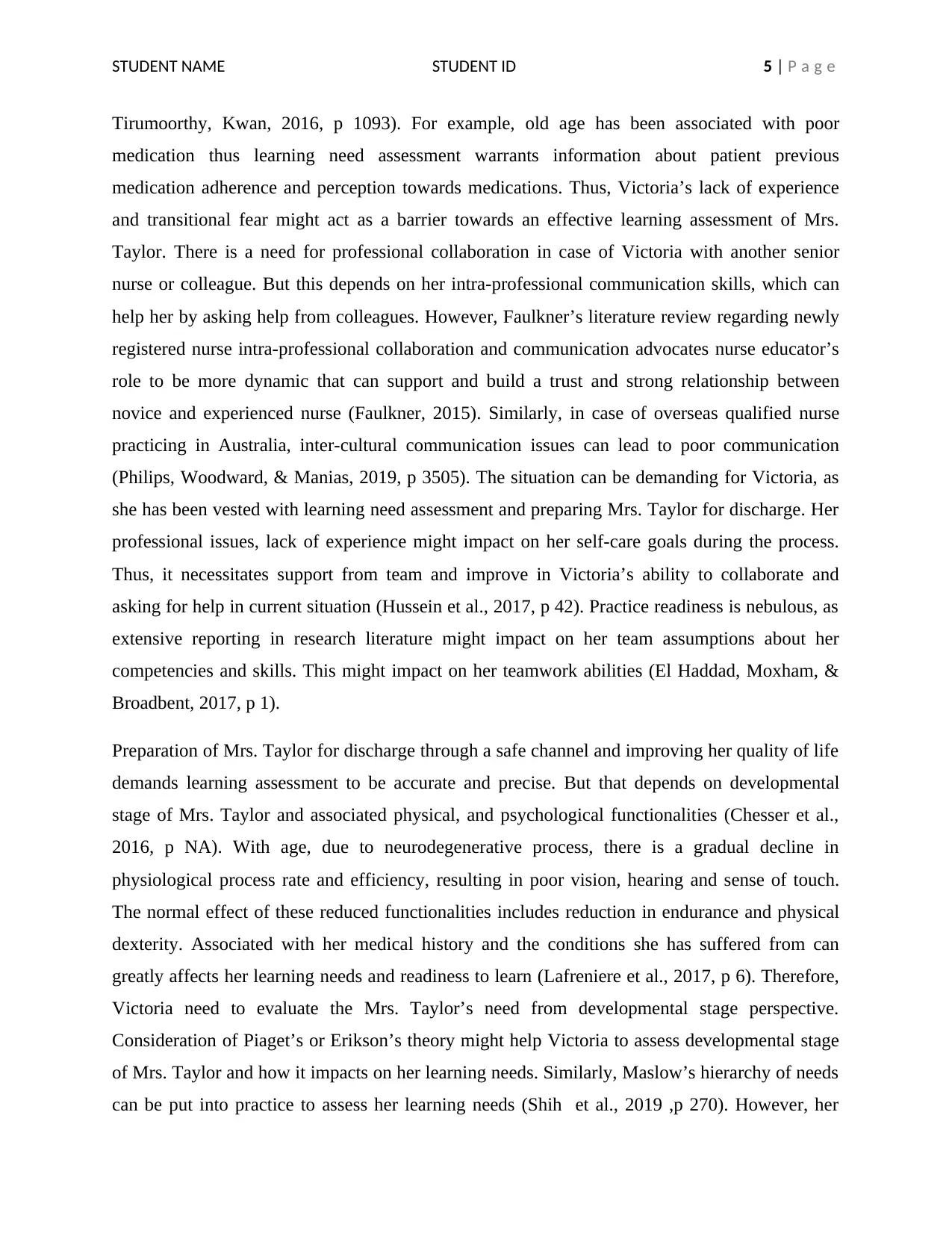
STUDENT NAME STUDENT ID 5 | P a g e
Tirumoorthy, Kwan, 2016, p 1093). For example, old age has been associated with poor
medication thus learning need assessment warrants information about patient previous
medication adherence and perception towards medications. Thus, Victoria’s lack of experience
and transitional fear might act as a barrier towards an effective learning assessment of Mrs.
Taylor. There is a need for professional collaboration in case of Victoria with another senior
nurse or colleague. But this depends on her intra-professional communication skills, which can
help her by asking help from colleagues. However, Faulkner’s literature review regarding newly
registered nurse intra-professional collaboration and communication advocates nurse educator’s
role to be more dynamic that can support and build a trust and strong relationship between
novice and experienced nurse (Faulkner, 2015). Similarly, in case of overseas qualified nurse
practicing in Australia, inter-cultural communication issues can lead to poor communication
(Philips, Woodward, & Manias, 2019, p 3505). The situation can be demanding for Victoria, as
she has been vested with learning need assessment and preparing Mrs. Taylor for discharge. Her
professional issues, lack of experience might impact on her self-care goals during the process.
Thus, it necessitates support from team and improve in Victoria’s ability to collaborate and
asking for help in current situation (Hussein et al., 2017, p 42). Practice readiness is nebulous, as
extensive reporting in research literature might impact on her team assumptions about her
competencies and skills. This might impact on her teamwork abilities (El Haddad, Moxham, &
Broadbent, 2017, p 1).
Preparation of Mrs. Taylor for discharge through a safe channel and improving her quality of life
demands learning assessment to be accurate and precise. But that depends on developmental
stage of Mrs. Taylor and associated physical, and psychological functionalities (Chesser et al.,
2016, p NA). With age, due to neurodegenerative process, there is a gradual decline in
physiological process rate and efficiency, resulting in poor vision, hearing and sense of touch.
The normal effect of these reduced functionalities includes reduction in endurance and physical
dexterity. Associated with her medical history and the conditions she has suffered from can
greatly affects her learning needs and readiness to learn (Lafreniere et al., 2017, p 6). Therefore,
Victoria need to evaluate the Mrs. Taylor’s need from developmental stage perspective.
Consideration of Piaget’s or Erikson’s theory might help Victoria to assess developmental stage
of Mrs. Taylor and how it impacts on her learning needs. Similarly, Maslow’s hierarchy of needs
can be put into practice to assess her learning needs (Shih et al., 2019 ,p 270). However, her
Tirumoorthy, Kwan, 2016, p 1093). For example, old age has been associated with poor
medication thus learning need assessment warrants information about patient previous
medication adherence and perception towards medications. Thus, Victoria’s lack of experience
and transitional fear might act as a barrier towards an effective learning assessment of Mrs.
Taylor. There is a need for professional collaboration in case of Victoria with another senior
nurse or colleague. But this depends on her intra-professional communication skills, which can
help her by asking help from colleagues. However, Faulkner’s literature review regarding newly
registered nurse intra-professional collaboration and communication advocates nurse educator’s
role to be more dynamic that can support and build a trust and strong relationship between
novice and experienced nurse (Faulkner, 2015). Similarly, in case of overseas qualified nurse
practicing in Australia, inter-cultural communication issues can lead to poor communication
(Philips, Woodward, & Manias, 2019, p 3505). The situation can be demanding for Victoria, as
she has been vested with learning need assessment and preparing Mrs. Taylor for discharge. Her
professional issues, lack of experience might impact on her self-care goals during the process.
Thus, it necessitates support from team and improve in Victoria’s ability to collaborate and
asking for help in current situation (Hussein et al., 2017, p 42). Practice readiness is nebulous, as
extensive reporting in research literature might impact on her team assumptions about her
competencies and skills. This might impact on her teamwork abilities (El Haddad, Moxham, &
Broadbent, 2017, p 1).
Preparation of Mrs. Taylor for discharge through a safe channel and improving her quality of life
demands learning assessment to be accurate and precise. But that depends on developmental
stage of Mrs. Taylor and associated physical, and psychological functionalities (Chesser et al.,
2016, p NA). With age, due to neurodegenerative process, there is a gradual decline in
physiological process rate and efficiency, resulting in poor vision, hearing and sense of touch.
The normal effect of these reduced functionalities includes reduction in endurance and physical
dexterity. Associated with her medical history and the conditions she has suffered from can
greatly affects her learning needs and readiness to learn (Lafreniere et al., 2017, p 6). Therefore,
Victoria need to evaluate the Mrs. Taylor’s need from developmental stage perspective.
Consideration of Piaget’s or Erikson’s theory might help Victoria to assess developmental stage
of Mrs. Taylor and how it impacts on her learning needs. Similarly, Maslow’s hierarchy of needs
can be put into practice to assess her learning needs (Shih et al., 2019 ,p 270). However, her
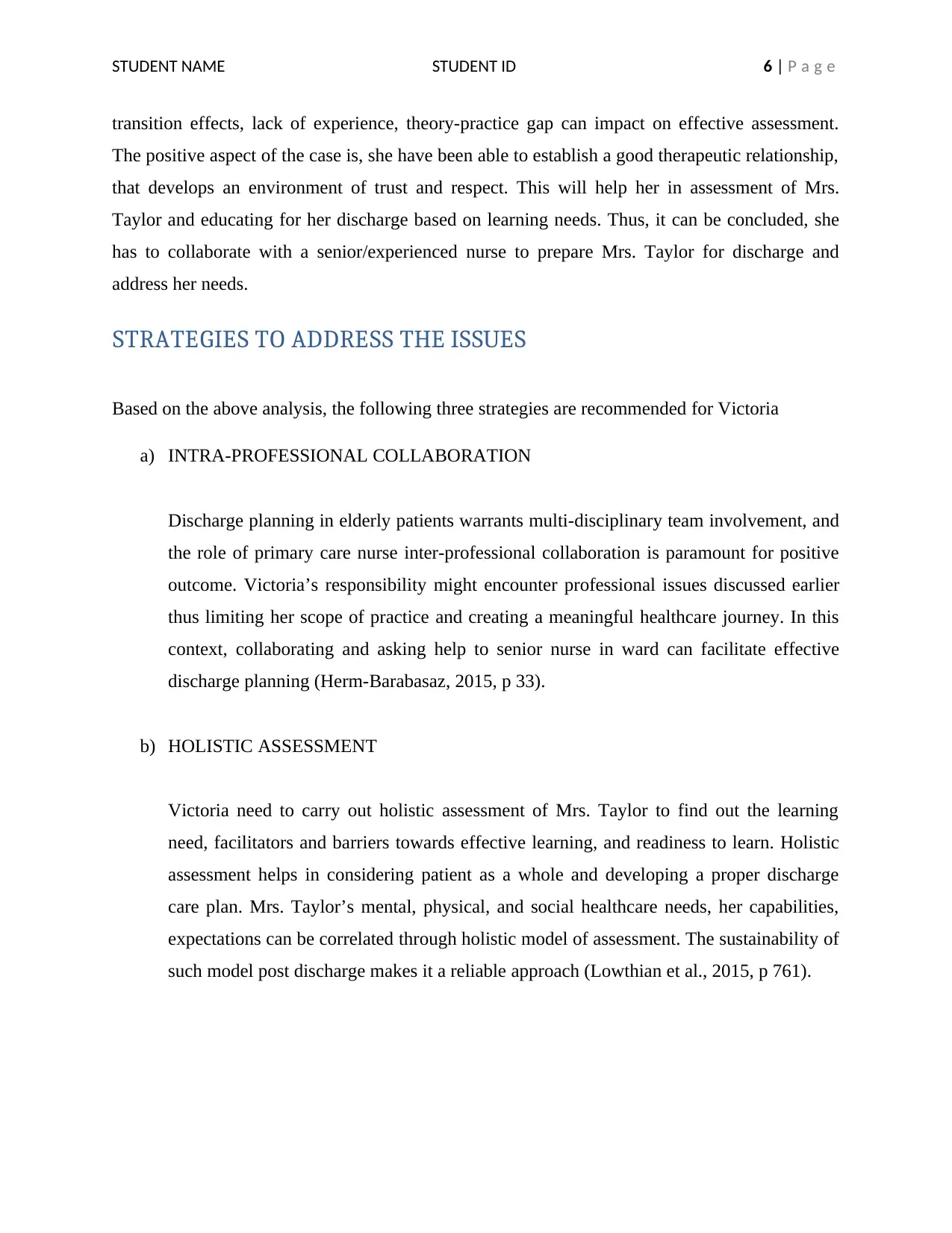
STUDENT NAME STUDENT ID 6 | P a g e
transition effects, lack of experience, theory-practice gap can impact on effective assessment.
The positive aspect of the case is, she have been able to establish a good therapeutic relationship,
that develops an environment of trust and respect. This will help her in assessment of Mrs.
Taylor and educating for her discharge based on learning needs. Thus, it can be concluded, she
has to collaborate with a senior/experienced nurse to prepare Mrs. Taylor for discharge and
address her needs.
STRATEGIES TO ADDRESS THE ISSUES
Based on the above analysis, the following three strategies are recommended for Victoria
a) INTRA-PROFESSIONAL COLLABORATION
Discharge planning in elderly patients warrants multi-disciplinary team involvement, and
the role of primary care nurse inter-professional collaboration is paramount for positive
outcome. Victoria’s responsibility might encounter professional issues discussed earlier
thus limiting her scope of practice and creating a meaningful healthcare journey. In this
context, collaborating and asking help to senior nurse in ward can facilitate effective
discharge planning (Herm-Barabasaz, 2015, p 33).
b) HOLISTIC ASSESSMENT
Victoria need to carry out holistic assessment of Mrs. Taylor to find out the learning
need, facilitators and barriers towards effective learning, and readiness to learn. Holistic
assessment helps in considering patient as a whole and developing a proper discharge
care plan. Mrs. Taylor’s mental, physical, and social healthcare needs, her capabilities,
expectations can be correlated through holistic model of assessment. The sustainability of
such model post discharge makes it a reliable approach (Lowthian et al., 2015, p 761).
transition effects, lack of experience, theory-practice gap can impact on effective assessment.
The positive aspect of the case is, she have been able to establish a good therapeutic relationship,
that develops an environment of trust and respect. This will help her in assessment of Mrs.
Taylor and educating for her discharge based on learning needs. Thus, it can be concluded, she
has to collaborate with a senior/experienced nurse to prepare Mrs. Taylor for discharge and
address her needs.
STRATEGIES TO ADDRESS THE ISSUES
Based on the above analysis, the following three strategies are recommended for Victoria
a) INTRA-PROFESSIONAL COLLABORATION
Discharge planning in elderly patients warrants multi-disciplinary team involvement, and
the role of primary care nurse inter-professional collaboration is paramount for positive
outcome. Victoria’s responsibility might encounter professional issues discussed earlier
thus limiting her scope of practice and creating a meaningful healthcare journey. In this
context, collaborating and asking help to senior nurse in ward can facilitate effective
discharge planning (Herm-Barabasaz, 2015, p 33).
b) HOLISTIC ASSESSMENT
Victoria need to carry out holistic assessment of Mrs. Taylor to find out the learning
need, facilitators and barriers towards effective learning, and readiness to learn. Holistic
assessment helps in considering patient as a whole and developing a proper discharge
care plan. Mrs. Taylor’s mental, physical, and social healthcare needs, her capabilities,
expectations can be correlated through holistic model of assessment. The sustainability of
such model post discharge makes it a reliable approach (Lowthian et al., 2015, p 761).

STUDENT NAME STUDENT ID 7 | P a g e
c) KNOWLEDGE ABOUT REFERRAL SERVICES
Post Discharge, Mrs. Taylor need to have adequate nutrition, proper environment to
prevent home isolation, assistance for socialization and proper care. The coping
strategies, self-care ability and self-management in this context is important to ensure her
safe transition to home. Mrs. Taylor might need residential care services for her
nutritional status maintenance, social care service to assist her in visiting market,
psychological counselor, or community-based therapy to prevent depression recurrence.
However, these referral service proposals can be given only when, Victoria have detailed
knowledge about each referral services and what role they play in enhancing wellbeing
and independence in older patients (Buikstra, Strivens, & Clay, 2020, p 137).
CONCLUSION
The case of Mrs. Taylor signifies the importance of intra-professional communication,
and therapeutic relationship establishment relevance in aged care. Victoria’s interest in
Mrs. Taylor and establishing a strong rapport suggest, novice nurse interest play a crucial
role in role development. Allowing Victoria to handle Mrs. Taylor learning need and
assess demonstrates peer pressure and expectation novice nurses face in transition. The
discharge planning depends on how well the patient was assessed and her needs are
addressed. Victoria need to be supported by team to facilitate proper discharge planning
and age based effective learning for Mrs. Victoria.
c) KNOWLEDGE ABOUT REFERRAL SERVICES
Post Discharge, Mrs. Taylor need to have adequate nutrition, proper environment to
prevent home isolation, assistance for socialization and proper care. The coping
strategies, self-care ability and self-management in this context is important to ensure her
safe transition to home. Mrs. Taylor might need residential care services for her
nutritional status maintenance, social care service to assist her in visiting market,
psychological counselor, or community-based therapy to prevent depression recurrence.
However, these referral service proposals can be given only when, Victoria have detailed
knowledge about each referral services and what role they play in enhancing wellbeing
and independence in older patients (Buikstra, Strivens, & Clay, 2020, p 137).
CONCLUSION
The case of Mrs. Taylor signifies the importance of intra-professional communication,
and therapeutic relationship establishment relevance in aged care. Victoria’s interest in
Mrs. Taylor and establishing a strong rapport suggest, novice nurse interest play a crucial
role in role development. Allowing Victoria to handle Mrs. Taylor learning need and
assess demonstrates peer pressure and expectation novice nurses face in transition. The
discharge planning depends on how well the patient was assessed and her needs are
addressed. Victoria need to be supported by team to facilitate proper discharge planning
and age based effective learning for Mrs. Victoria.
Paraphrase This Document
Need a fresh take? Get an instant paraphrase of this document with our AI Paraphraser
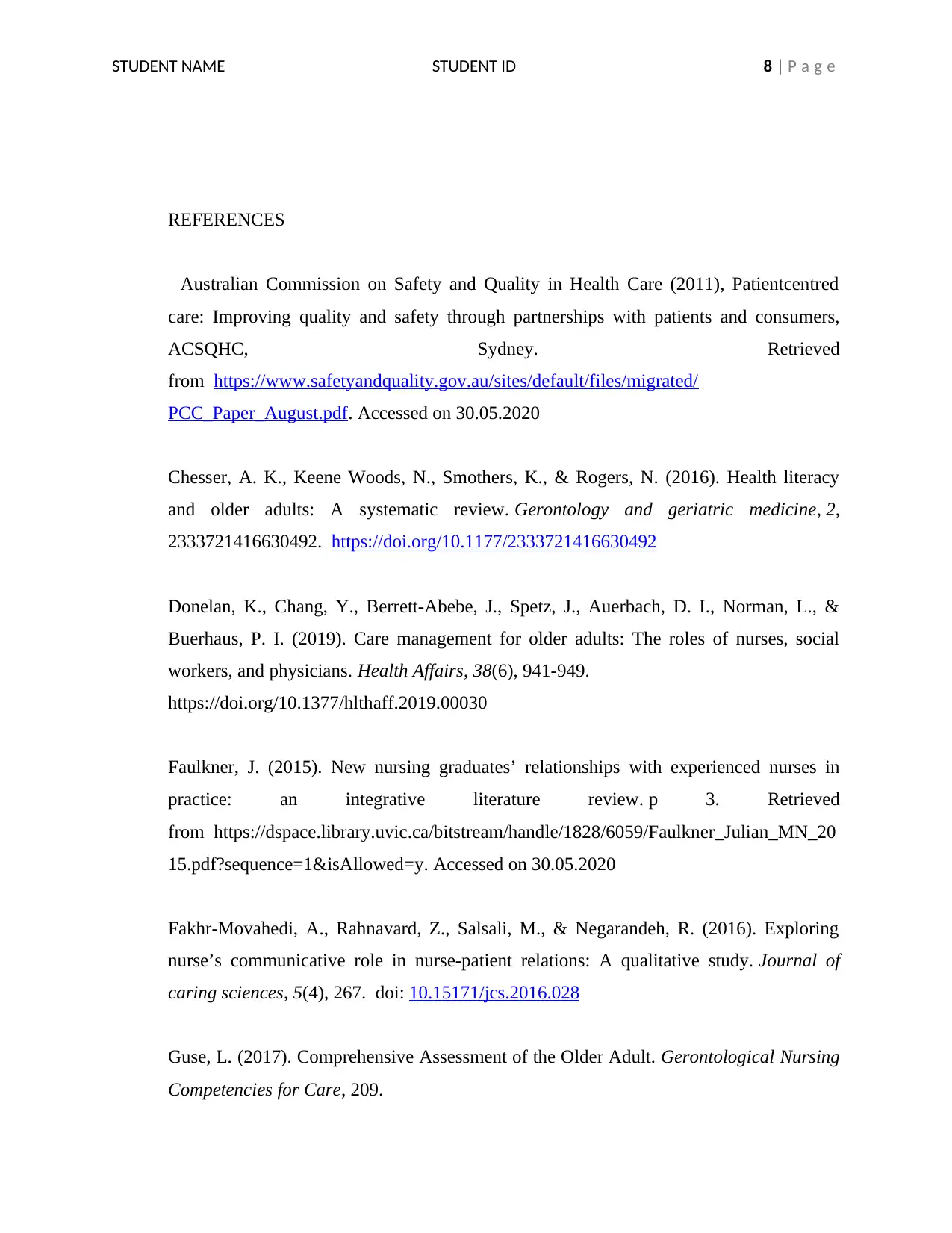
STUDENT NAME STUDENT ID 8 | P a g e
REFERENCES
Australian Commission on Safety and Quality in Health Care (2011), Patientcentred
care: Improving quality and safety through partnerships with patients and consumers,
ACSQHC, Sydney. Retrieved
from https://www.safetyandquality.gov.au/sites/default/files/migrated/
PCC_Paper_August.pdf. Accessed on 30.05.2020
Chesser, A. K., Keene Woods, N., Smothers, K., & Rogers, N. (2016). Health literacy
and older adults: A systematic review. Gerontology and geriatric medicine, 2,
2333721416630492. https://doi.org/10.1177/2333721416630492
Donelan, K., Chang, Y., Berrett-Abebe, J., Spetz, J., Auerbach, D. I., Norman, L., &
Buerhaus, P. I. (2019). Care management for older adults: The roles of nurses, social
workers, and physicians. Health Affairs, 38(6), 941-949.
https://doi.org/10.1377/hlthaff.2019.00030
Faulkner, J. (2015). New nursing graduates’ relationships with experienced nurses in
practice: an integrative literature review. p 3. Retrieved
from https://dspace.library.uvic.ca/bitstream/handle/1828/6059/Faulkner_Julian_MN_20
15.pdf?sequence=1&isAllowed=y. Accessed on 30.05.2020
Fakhr-Movahedi, A., Rahnavard, Z., Salsali, M., & Negarandeh, R. (2016). Exploring
nurse’s communicative role in nurse-patient relations: A qualitative study. Journal of
caring sciences, 5(4), 267. doi: 10.15171/jcs.2016.028
Guse, L. (2017). Comprehensive Assessment of the Older Adult. Gerontological Nursing
Competencies for Care, 209.
REFERENCES
Australian Commission on Safety and Quality in Health Care (2011), Patientcentred
care: Improving quality and safety through partnerships with patients and consumers,
ACSQHC, Sydney. Retrieved
from https://www.safetyandquality.gov.au/sites/default/files/migrated/
PCC_Paper_August.pdf. Accessed on 30.05.2020
Chesser, A. K., Keene Woods, N., Smothers, K., & Rogers, N. (2016). Health literacy
and older adults: A systematic review. Gerontology and geriatric medicine, 2,
2333721416630492. https://doi.org/10.1177/2333721416630492
Donelan, K., Chang, Y., Berrett-Abebe, J., Spetz, J., Auerbach, D. I., Norman, L., &
Buerhaus, P. I. (2019). Care management for older adults: The roles of nurses, social
workers, and physicians. Health Affairs, 38(6), 941-949.
https://doi.org/10.1377/hlthaff.2019.00030
Faulkner, J. (2015). New nursing graduates’ relationships with experienced nurses in
practice: an integrative literature review. p 3. Retrieved
from https://dspace.library.uvic.ca/bitstream/handle/1828/6059/Faulkner_Julian_MN_20
15.pdf?sequence=1&isAllowed=y. Accessed on 30.05.2020
Fakhr-Movahedi, A., Rahnavard, Z., Salsali, M., & Negarandeh, R. (2016). Exploring
nurse’s communicative role in nurse-patient relations: A qualitative study. Journal of
caring sciences, 5(4), 267. doi: 10.15171/jcs.2016.028
Guse, L. (2017). Comprehensive Assessment of the Older Adult. Gerontological Nursing
Competencies for Care, 209.

STUDENT NAME STUDENT ID 9 | P a g e
Herm-Barabasz, R. M. (2015). Intraprofessional Nursing Communication and
Collaboration: APN-RN-Patient Bedside Rounding.Retrieved
from https://digitalscholarship.unlv.edu/cgi/viewcontent.cgi?
article=3364&context=thesesdissertations. Accessed on 30.05.2020
El Haddad, M., Moxham, L., & Broadbent, M. (2017). Graduate nurse practice readiness:
A conceptual understanding of an age old debate. Collegian, 24(4), 391-396. Retrieved
from https://ro.uow.edu.au/cgi/viewcontent.cgi?article=5685&context=smhpapers.
Accessed on 30.05.2020
Lafrenière, S., Folch, N., Dubois, S., Bédard, L., & Ducharme, F. (2017). Strategies used
by older patients to prevent functional decline during hospitalization. Clinical nursing
research, 26(1), 6-26. https://doi.org/10.1177/1054773815601392
Lowthian, J. A., McGinnes, R. A., Brand, C. A., Barker, A. L., & Cameron, P. A. (2015).
Discharging older patients from the emergency department effectively: a systematic
review and meta-analysis. Age and ageing, 44(5), 761-
770. https://doi.org/10.1093/ageing/afv102
Ozaras, G., & Abaan, S. (2018). Investigation of the trust status of the nurse–patient
relationship. Nursing ethics, 25(5), 628-639. DOI: 10.1177/0969733016664971
Price, B. (2017). Developing patient rapport, trust and therapeutic relationships. Nursing
Standard, 31(50). 50, 52-61 doi: 10.7748/ns.2017.e10909
McAllister, S., Robert, G., Tsianakas, V., & McCrae, N. (2019). Conceptualising nurse-
patient therapeutic engagement on acute mental health wards: An integrative
review. International journal of nursing studies. International Journal of Nursing Studies,
93, Pages 106-118. https://doi.org/10.1016/j.ijnurstu.2019.02.013
Herm-Barabasz, R. M. (2015). Intraprofessional Nursing Communication and
Collaboration: APN-RN-Patient Bedside Rounding.Retrieved
from https://digitalscholarship.unlv.edu/cgi/viewcontent.cgi?
article=3364&context=thesesdissertations. Accessed on 30.05.2020
El Haddad, M., Moxham, L., & Broadbent, M. (2017). Graduate nurse practice readiness:
A conceptual understanding of an age old debate. Collegian, 24(4), 391-396. Retrieved
from https://ro.uow.edu.au/cgi/viewcontent.cgi?article=5685&context=smhpapers.
Accessed on 30.05.2020
Lafrenière, S., Folch, N., Dubois, S., Bédard, L., & Ducharme, F. (2017). Strategies used
by older patients to prevent functional decline during hospitalization. Clinical nursing
research, 26(1), 6-26. https://doi.org/10.1177/1054773815601392
Lowthian, J. A., McGinnes, R. A., Brand, C. A., Barker, A. L., & Cameron, P. A. (2015).
Discharging older patients from the emergency department effectively: a systematic
review and meta-analysis. Age and ageing, 44(5), 761-
770. https://doi.org/10.1093/ageing/afv102
Ozaras, G., & Abaan, S. (2018). Investigation of the trust status of the nurse–patient
relationship. Nursing ethics, 25(5), 628-639. DOI: 10.1177/0969733016664971
Price, B. (2017). Developing patient rapport, trust and therapeutic relationships. Nursing
Standard, 31(50). 50, 52-61 doi: 10.7748/ns.2017.e10909
McAllister, S., Robert, G., Tsianakas, V., & McCrae, N. (2019). Conceptualising nurse-
patient therapeutic engagement on acute mental health wards: An integrative
review. International journal of nursing studies. International Journal of Nursing Studies,
93, Pages 106-118. https://doi.org/10.1016/j.ijnurstu.2019.02.013
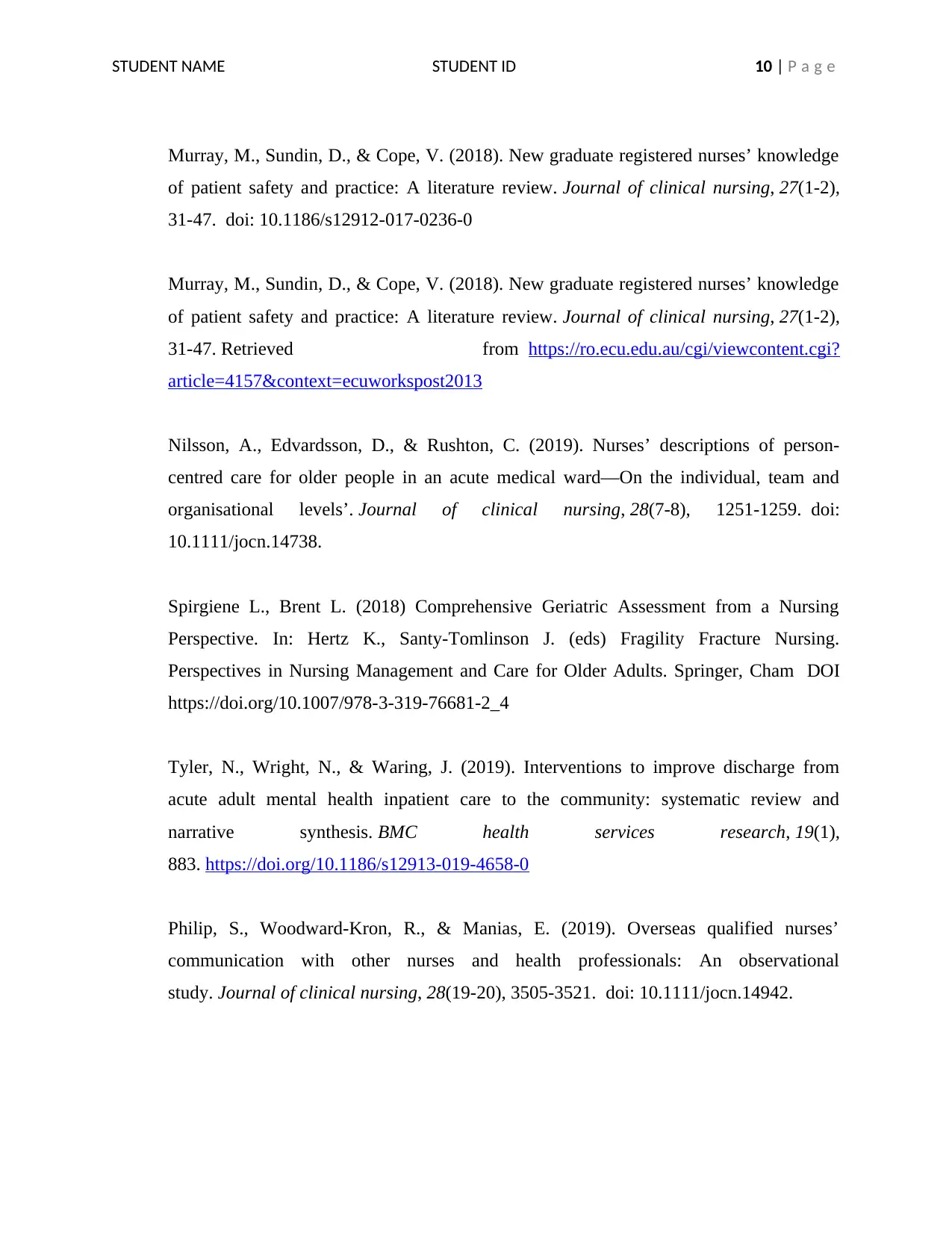
STUDENT NAME STUDENT ID 10 | P a g e
Murray, M., Sundin, D., & Cope, V. (2018). New graduate registered nurses’ knowledge
of patient safety and practice: A literature review. Journal of clinical nursing, 27(1-2),
31-47. doi: 10.1186/s12912-017-0236-0
Murray, M., Sundin, D., & Cope, V. (2018). New graduate registered nurses’ knowledge
of patient safety and practice: A literature review. Journal of clinical nursing, 27(1-2),
31-47. Retrieved from https://ro.ecu.edu.au/cgi/viewcontent.cgi?
article=4157&context=ecuworkspost2013
Nilsson, A., Edvardsson, D., & Rushton, C. (2019). Nurses’ descriptions of person‐
centred care for older people in an acute medical ward—On the individual, team and
organisational levels’. Journal of clinical nursing, 28(7-8), 1251-1259. doi:
10.1111/jocn.14738.
Spirgiene L., Brent L. (2018) Comprehensive Geriatric Assessment from a Nursing
Perspective. In: Hertz K., Santy-Tomlinson J. (eds) Fragility Fracture Nursing.
Perspectives in Nursing Management and Care for Older Adults. Springer, Cham DOI
https://doi.org/10.1007/978-3-319-76681-2_4
Tyler, N., Wright, N., & Waring, J. (2019). Interventions to improve discharge from
acute adult mental health inpatient care to the community: systematic review and
narrative synthesis. BMC health services research, 19(1),
883. https://doi.org/10.1186/s12913-019-4658-0
Philip, S., Woodward‐Kron, R., & Manias, E. (2019). Overseas qualified nurses’
communication with other nurses and health professionals: An observational
study. Journal of clinical nursing, 28(19-20), 3505-3521. doi: 10.1111/jocn.14942.
Murray, M., Sundin, D., & Cope, V. (2018). New graduate registered nurses’ knowledge
of patient safety and practice: A literature review. Journal of clinical nursing, 27(1-2),
31-47. doi: 10.1186/s12912-017-0236-0
Murray, M., Sundin, D., & Cope, V. (2018). New graduate registered nurses’ knowledge
of patient safety and practice: A literature review. Journal of clinical nursing, 27(1-2),
31-47. Retrieved from https://ro.ecu.edu.au/cgi/viewcontent.cgi?
article=4157&context=ecuworkspost2013
Nilsson, A., Edvardsson, D., & Rushton, C. (2019). Nurses’ descriptions of person‐
centred care for older people in an acute medical ward—On the individual, team and
organisational levels’. Journal of clinical nursing, 28(7-8), 1251-1259. doi:
10.1111/jocn.14738.
Spirgiene L., Brent L. (2018) Comprehensive Geriatric Assessment from a Nursing
Perspective. In: Hertz K., Santy-Tomlinson J. (eds) Fragility Fracture Nursing.
Perspectives in Nursing Management and Care for Older Adults. Springer, Cham DOI
https://doi.org/10.1007/978-3-319-76681-2_4
Tyler, N., Wright, N., & Waring, J. (2019). Interventions to improve discharge from
acute adult mental health inpatient care to the community: systematic review and
narrative synthesis. BMC health services research, 19(1),
883. https://doi.org/10.1186/s12913-019-4658-0
Philip, S., Woodward‐Kron, R., & Manias, E. (2019). Overseas qualified nurses’
communication with other nurses and health professionals: An observational
study. Journal of clinical nursing, 28(19-20), 3505-3521. doi: 10.1111/jocn.14942.
Secure Best Marks with AI Grader
Need help grading? Try our AI Grader for instant feedback on your assignments.
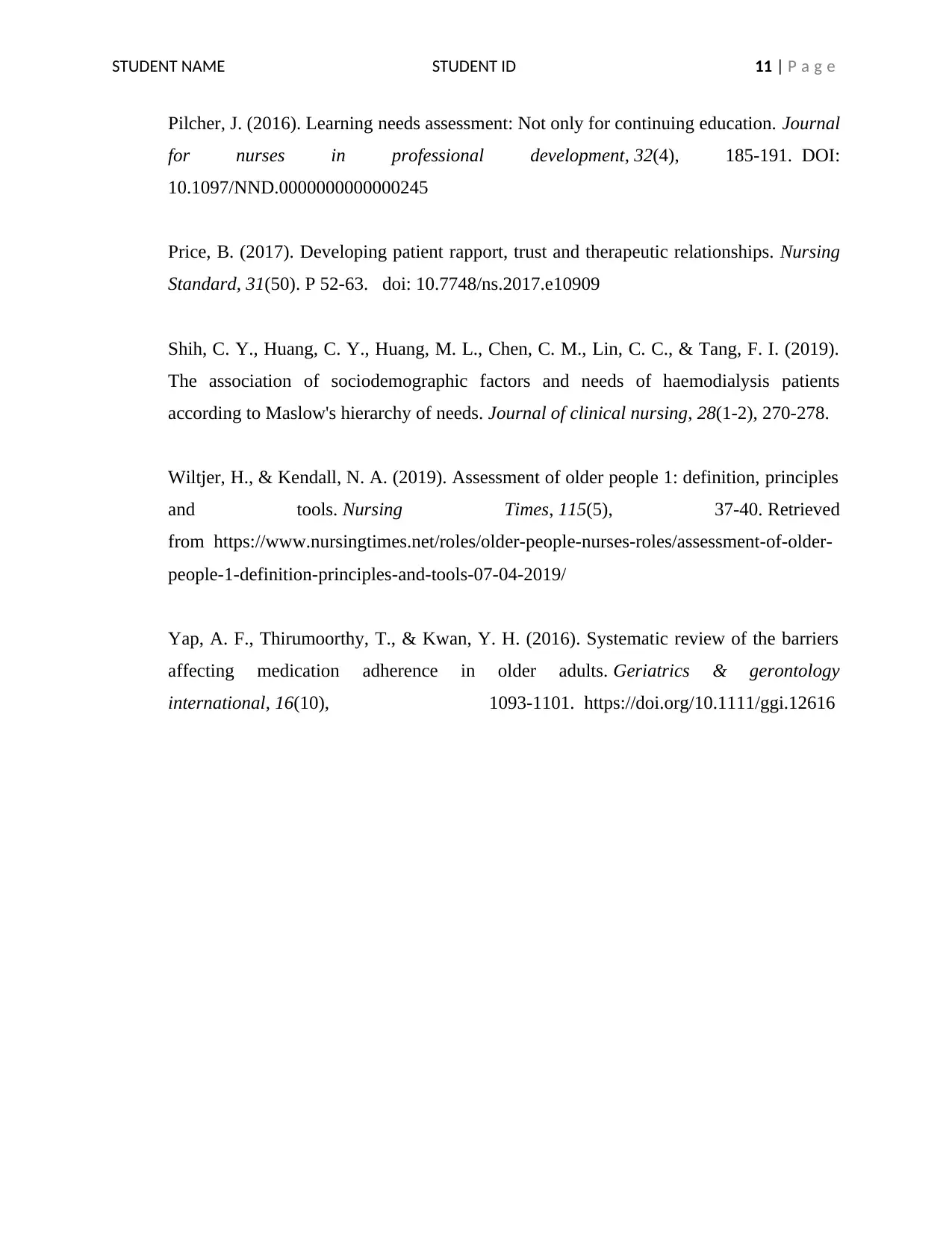
STUDENT NAME STUDENT ID 11 | P a g e
Pilcher, J. (2016). Learning needs assessment: Not only for continuing education. Journal
for nurses in professional development, 32(4), 185-191. DOI:
10.1097/NND.0000000000000245
Price, B. (2017). Developing patient rapport, trust and therapeutic relationships. Nursing
Standard, 31(50). P 52-63. doi: 10.7748/ns.2017.e10909
Shih, C. Y., Huang, C. Y., Huang, M. L., Chen, C. M., Lin, C. C., & Tang, F. I. (2019).
The association of sociodemographic factors and needs of haemodialysis patients
according to Maslow's hierarchy of needs. Journal of clinical nursing, 28(1-2), 270-278.
Wiltjer, H., & Kendall, N. A. (2019). Assessment of older people 1: definition, principles
and tools. Nursing Times, 115(5), 37-40. Retrieved
from https://www.nursingtimes.net/roles/older-people-nurses-roles/assessment-of-older-
people-1-definition-principles-and-tools-07-04-2019/
Yap, A. F., Thirumoorthy, T., & Kwan, Y. H. (2016). Systematic review of the barriers
affecting medication adherence in older adults. Geriatrics & gerontology
international, 16(10), 1093-1101. https://doi.org/10.1111/ggi.12616
Pilcher, J. (2016). Learning needs assessment: Not only for continuing education. Journal
for nurses in professional development, 32(4), 185-191. DOI:
10.1097/NND.0000000000000245
Price, B. (2017). Developing patient rapport, trust and therapeutic relationships. Nursing
Standard, 31(50). P 52-63. doi: 10.7748/ns.2017.e10909
Shih, C. Y., Huang, C. Y., Huang, M. L., Chen, C. M., Lin, C. C., & Tang, F. I. (2019).
The association of sociodemographic factors and needs of haemodialysis patients
according to Maslow's hierarchy of needs. Journal of clinical nursing, 28(1-2), 270-278.
Wiltjer, H., & Kendall, N. A. (2019). Assessment of older people 1: definition, principles
and tools. Nursing Times, 115(5), 37-40. Retrieved
from https://www.nursingtimes.net/roles/older-people-nurses-roles/assessment-of-older-
people-1-definition-principles-and-tools-07-04-2019/
Yap, A. F., Thirumoorthy, T., & Kwan, Y. H. (2016). Systematic review of the barriers
affecting medication adherence in older adults. Geriatrics & gerontology
international, 16(10), 1093-1101. https://doi.org/10.1111/ggi.12616
1 out of 11
Related Documents
Your All-in-One AI-Powered Toolkit for Academic Success.
+13062052269
info@desklib.com
Available 24*7 on WhatsApp / Email
![[object Object]](/_next/static/media/star-bottom.7253800d.svg)
Unlock your academic potential
© 2024 | Zucol Services PVT LTD | All rights reserved.





